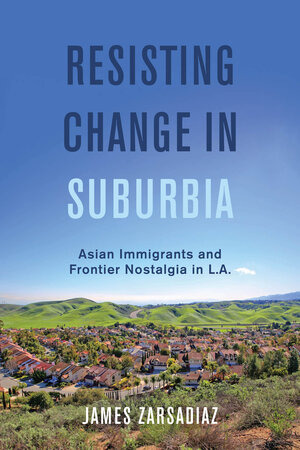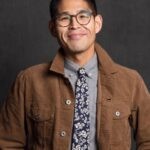By James Zarsadiaz, author of Resisting Change in Suburbia: Asian Immigrants and Frontier Nostalgia in L.A.
Today, notions of an urban and liberal Asian America continue to prevail, even though Asian Americans are the most suburbanized people of color and have been among the most vocal critics of progressive positions regarding affirmative action, criminal justice reform, and more recently, so-called “woke” curriculum. Each of these phenomena – that is, Asian American suburbanization and an outspoken Asian American right – are not recent developments. I explore these themes and others in my new book, Resisting Change in Suburbia: Asian Immigrants and Frontier Nostalgia in L.A. As a historian whose work intersects with Urban Studies and Ethnic Studies, I set out to examine a slice of the Asian American experience that was not rooted in the city (e.g., Chinatown) and one that illustrated Asian immigrants’ deep ties with local and national conservative movements.
In my book, I address how ideas of race and the American West informed suburban planning in Southern California, and how intra-Asian divisions or hierarchies were exacerbated by class differences and perceptions of taste measured by zip code (e.g., Taiwanese families in affluent suburbs vs. Southeast Asian families in lower middle-class suburbs). At its core, Resisting Change in Suburbia is about the power of myths, especially those of the suburbs, the American West, and the American Dream. These myths influenced suburbanites’ experiences in a globalizing United States, as well as the lengths people went to protect these ideas. The book focuses on Los Angeles’ East San Gabriel Valley (a.k.a. “East Valley”) between the 1970s and 2010s – a period of rapid suburbanization, transnational economic growth, and palpable demographic turns.
Whether families settled in this area during the 1960s or the 1990s, many claimed to live in L.A.’s final frontier. In their eyes, the East Valley was a relic of a timeless American West. Residents were invested in what they called “country living.” This was largely because developers, builders, advertisers, and realtors positioned these places as pastoral enclaves removed from the vice, crowdedness, and disorder of the city. For some, the distance also meant their families were not forced to engage with L.A.’s racial and class diversity – which was associated with those issues.
From exploring archives of commission minutes, ads, and HOA newsletters, and doing oral history interviews, I found that the East Valley was often dubbed a place of gracious country living, and that residents were frustrated with “change.” Homeowners were drawn to the trappings of country living suburbia because the landscape and culture suggested they were shielded from the forces of modernity and globalization. But like other parts of Southern California in the late 20th century, the East Valley did change because of these phenomena. From critics’ perspectives, change – due to increased density and diversity – made country living feel more urban, thus marring their quality of life. Throughout the 1980s and beyond – whether articulated in everyday conversations, city council races, or newspaper interviews – homeowners used change to describe their discomforts with the valley’s shifting demographics and physical landscape. In other words, this was a class- and color-blind way to express disapproval, fear, and rage during a time when explicit bigotry was out and tolerance or multiculturalism were in.
Concerns about change also occurred amid an influx of wealthier, transnational Asian immigrants, primarily from Hong Kong, Taiwan, the Philippines, and South Korea. Hundreds of Asian families purchased houses in sprawling master-planned tracts. Their presence suggested permanence and relayed ideas of an immigrant “takeover,” which residents quantified in the number of Asian-owned retail or religious spaces. Design, architecture, and aesthetics also took center stage in critics’ trepidations with change. To make matters worse, nativist-driven rumors fanned flames on divisive neighborhood issues and in hotly-contested elections.
Ironically, while critics lambasted Asian immigrants for disrupting suburban mores, they found many Asian American allies in their cause to defend country living well into the 21st century. Like their white neighbors, Chinese, Filipino, and Korean families also enjoyed the perceived refinement and “all-American” look and feel of the East Valley’s subdivisions. The global reach of U.S. imperialism and popular Hollywood-made media, which romanticized suburbia and glamourized West Coast living, shaped would-be immigrants’ material goals. Once settled in suburban L.A., they worked to stop change in their communities, particularly when it came to policies that threatened property values. Throughout the 1990s and 2000s, white and Asian homeowners collectively prevented the construction of a landfill and multiple discount or “ethnic” stores (e.g., Target, 99 Ranch Market); actively or tacitly backed municipal codes muting the presence of Asian cultural expression in the built environment (e.g., English language ordinances); and advocated for redistricting school district boundaries that would favor upper-income families.
Ultimately, Asian immigrant homeowners sought to live within a particular image of the “classic” American suburb. It wasn’t just their white counterparts who wished to maintain suburbia’s Euro-American flavor. In doing so, Asian Americans believed they demonstrated their assimilability and preserved their privileges as a hard-working propertied class. Their actions —or inactions—safeguarded a fashionable lifestyle they desired even before touching ground on this side of the Pacific.
Visit our SHAFR 2023 virtual exhibit page to get 40% off the book for a limited time.

